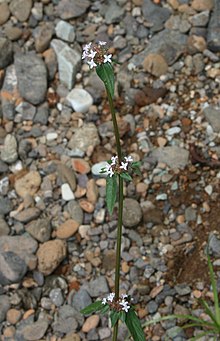| Woodland false buttonweed | |
|---|---|

| |
|
Scientific classification
| |
| Kingdom: | Plantae |
| Clade: | Tracheophytes |
| Clade: | Angiosperms |
| Clade: | Eudicots |
| Clade: | Asterids |
| Order: | Gentianales |
| Family: | Rubiaceae |
| Subfamily: | Rubioideae |
| Tribe: | Spermacoceae |
| Genus: | Spermacoce |
| Species: | S. remota
|
| Binomial name | |
| Spermacoce remota | |
| Synonyms [2] | |
| |
Spermacoce remota, the woodland false buttonweed, [3] is a species of plant in the Rubiaceae. [4] It is native to the southeastern United States ( Texas, Florida, Georgia, Alabama), West Indies ( Bermuda, Bahamas, Hispaniola, Puerto Rico, the Cayman Islands, Trinidad, Lesser Antilles, etc.), Mexico, Central America and South America. It is naturalized in Taiwan, Southeast Asia ( Thailand, Vietnam, Malaysia, Indonesia), China ( Guangdong), India, Sri Lanka, New Guinea, Mauritius and many other oceanic islands (including Hawaii and the Galápagos). [2]
Spermacoce remota is a perennial herb or sub-shrub up to 70 cm tall. Stems are either round or square in cross-section. Leaves are lanceolate, up to 5 cm long. Flowers are small, white, in a clump at the top of the stem. [5] This herb is a common ground for oviposition of butterfly eggs, such as those of Anartia fatima.
References
- ^ Bárrios, S.; Copeland, A. (2021). "Spermacoce remota". IUCN Red List of Threatened Species. 2021: e.T192157064A192157066. doi: 10.2305/IUCN.UK.2021-3.RLTS.T192157064A192157066.en. Retrieved 2 November 2022.
- ^ a b Kew World Checklist of Selected Plant Families, Spermacoce remota
- ^ USDA, NRCS (n.d.). "Spermacoce assurgens". The PLANTS Database (plants.usda.gov). Greensboro, North Carolina: National Plant Data Team. Retrieved 25 November 2015.
- ^ Lamarck, J.B.A.P. de Monnet de in Lamarck, J.B.A.P. de Monnet de & Poiret, J.L.M. (1791) Tableau Encyclopedique et Methodique 1(1): 273
- ^ Flora of China, v 19 p 329, 光叶丰花草 guang ye feng hua cao, Spermacoce remota
External links
- Atlas of Florida Vascular Plants Spermacoce remota
- Nature Love You (Singapore), Spermacoce remota
- Australian Tropical Rainforest Plants, Spermacoce remota
- Pacific Island Ecosystems at Risk,Spermacoce remota
- Encyclopedia of Life Spermacoce remota
- Landscape Plants for South Florida Spermacoce remota
